Introduction
Green mussel is a commercially significant shellfish in the Philippines.1 It is top 6 among important aquaculture produced species with the latest production of 18, 800 metric tons.2 This commodity is commonly consumed as a cheap protein source in coastal areas. There was no established industry that primary process green mussel into shucked form pretreated with organic acids in the Philippines. It is generally utilized in their natural unopened condition for the local market.1
Bivalves have a short shelf life after harvest due to their neutral pH value, high amino acid and water activity. Their high microbial load is also acquired from their filter feeding nature that contributes to their shorter shelf life.3 Green mussel can be kept alive for 2 days after harvest when stored at ambient temperature.4 This period is not enough to transport green mussels from distant mussel farms to the markets. The development of an appropriate processing method for mussel is important to increase its shelf life.
Hurdle processes like low-temperature storage and application of chemicals can help enhance the shelf life.5 Organic acids are popularly used in the industry to enhance shelf life.6 They are safe to use since they are naturally met in vegetable and animal tissues.7 Lactic and citric acid are generally recognized as safe (GRAS) and are beneficial in extending the shelf life of the meat products subjected to cold storage.8 A study9 found out that 2% of lactic acid reduced pathogen levels in beef during chilled storage. There were no studies conducted in mussel using the said concentration for shelf life extension. Thus, this study utilized 2% concentration of lactic and citric acid in the pretreatment of green mussel subjected to 3˚C and assessed quality changes that occurred throughout the chilled storage.
Materials and Methods
Collection and Preparation of Mussel Samples
The green mussel was freshly harvested from Taytay, Palawan, Philippines. Samples were declustered at harvest area and stored in a styrofoam box insulated containing ice using mussel/ice ratio of 5:1 (w/w). The samples were transported to Iloilo, Philippines via airfreight and immediately brought to the processing laboratory within 7 hours of travel time from the harvest site. The mussels were washed with tap water to remove adhering dirt. Samples were sorted to remove dead mussels that exhibit foul odor and gaping.
Green mussels were subjected to blanching at 85˚C for 2 mins using of 1:5 mussel/water ratio (w/v). Then, the blanched mussel was submerged in iced water for immediate cooling. The cooled mussels were shucked and divided into three batches: control, (2%) lactic acid pretreatment, and (2%) citric acid pretreatment. Three kilos of mussel meat per group were utilized for pretreatments. All the samples were packed using Nylon PE bags (6in. x 10in. x 75 microns) and heat sealed. The storage condition of the pretreated green mussel was 3˚C±1˚C for 18 days. The analyses were performed every 3rd day to determine the overall quality of samples for 18 days.
Evaluation of Sensory Qualities
For the sensory analysis, mussels were wrapped using aluminum foil and subjected to steam for 18 minutes in boiling water. The sensory assessment of organic acid pretreated and control samples was done by using descriptive and acceptability test. Ten panelists assessed the odor (marine seaweed and ammoniacal), flavor (naturally sweet and sour) and acceptability (odor, flavor, and general) of green mussels. Before evaluation, test and parameters were explained to the panelists. They were reminded not to eat the samples during the sensory evaluation. Water and unsalted crackers were provided as taste neutralizer.
Microbiological Evaluation
The spread plating method was followed for the estimation of the microbial population in the green mussel samples. The 10 g mussel was weighed sterilely and homogenized with 90 ml of peptone water (0.01%). Then it was serially diluted tenfolds and spread plated on the agar. Lactic acid bacteria were determined on DeMann Rogosa Sharpe, MRS agar (TM Media, India), incubated at 37˚C for 48 h.10 While Plate count agar, PCA (TM Media, India) was used to enumerate psychrophilic bacteria and incubated at 8˚C for 5 days.11 The results were expressed in terms of log colony-forming unit (log CFU) per g of mussel sample.
Physico-Chemical Analysis
Determination of pH
The pH value of the green mussel with and without acid pretreatments was measured according to the standard method.12 The samples were homogenized and pH was determined using pen-type pH meter (OEM, China).
Determination of Weight Loss
For weight loss analysis, the green mussel was weighed per treatment, packed and subjected to chilled storage. The pre-weighed samples were withdrawn and weighed again at every sampling interval. Separate packs of the sample were prepared for every sampling period. The weight loss was determined using the formula13:
Weight loss (%) = initial weight/final weight x 100
Determination of Volatile Compounds
The volatile compounds including the total volatile basic nitrogen (TVB) and trimethylamine nitrogen (TMA) were analyzed according to the Conway method14 and the results were expressed as mg/100g N. Two grams of sample was homogenized with 8ml of 4% Trichloroacetic acid, TCA (RCI Labscan, Thailand) and filtered using Whatman filter paper No. 1. The extract was added to the outer ring of the Conway dish while the inner ring was added with 1% boric acid. Saturated potassium carbonate, K2CO3 (RCI Labscan, Thailand) was added to the sample extract to initiate the reaction. The Conway dish was closed and incubated for 60 mins. at 37ºC. The inner ring was titrated with 0.02N Hydrochloric acid, HCl (J.T. Baker, USA) until green turns pink. TMA was determined using the same procedure as TVB, but 10% neutralized formaldehyde (RCI Labscan, Thailand) was added to the sample extract.
Determination of Ammonia
The ammonia concentration of pretreated and untreated green mussel was measured and expressed as mg/g muscle.15 Two grams of the homogenized mussel sample was added with 5 ml of 15% TCA and mixed thoroughly. The extract was filtered using Whatman filter paper No. 1. The 1 ml filtrate was transferred to a test tube and added with 2 ml solution A and 1 ml solution B. The two solutions included phenol nitroprusside buffer (A) and alkaline hypochlorite (B) The samples were incubated at room temperature covered with aluminum foil for 30 minutes. Then samples were read at 635 nm using Agilent Cary Go UV-VIS spectrophotometer (Agilent, USA).
Statistical Analysis
The experiments were run in triplicate. The results were analyzed using one-way ANOVA and the mean was statistically evaluated using Duncan’s multiple range test (DMRT) with the level of significance set at p<0.05. All the statistical analyses were carried out using the SPSS (version 20) software (SPSS Inc., Chicago, Illinois).
Results and Discussion
Sensory Analysis
Sensory analysis is commonly utilized in the food industry to evaluate the quality of food products.16 The marine seaweed odor of pretreated and untreated samples had no significant differences at day 0, 3, and 6 (p˃0.05). For the ammoniacal odor, no differences between the three samples were perceived (Table 1). The pretreatment had effectively preserved the odor attribute of the samples compared to the untreated groups that were rejected on day 9th due to their ammoniacal odor. The scores of lactic and citric acid pretreated samples declined with storage but no significant difference was detected between the two organic acid pretreatments (p˃0.05). The naturally sweet flavor of lactic and citric acid pretreated samples had significantly low scores of 4.61 and 4.48, respectively, on the initial day of sampling compared to the untreated sample with 7.03 (p<0.05). The score of untreated sample declined on the day 6th and was rejected on day 9. The ATP initial degradation in fishery product results in an increasing amount of inosine monophosphate that enhances flavor but its further breakdown resulted in the loss of flavor.17 This was attributed to the declining flavor score of all the samples. The sourness score of the two pretreated samples had significant difference compared to untreated sample on day 0 to 6, but no significant difference was determined between the two samples (p<0.05). For the odor acceptability, the pretreatments effectively preserved the desired odor attribute of the green mussel in acceptable level preferred by panelist compared to the untreated sample that was rejected on day 9 (Table 2). The flavor acceptability of the two samples was also preserved until day 15th. And for the global acceptability, the two organic acid pretreatments also improved the sensory quality of green mussel until day 15 compared to the untreated sample that lasted until day 6th. Results obtained from this study were higher compared to the 7 days sensory acceptability of green mussel in chilled storage.18 Both organic acids help preserved the changes in sensory quality of chilled green mussel but lactic acid had been acceptable for longer storage days compared to citric acid.
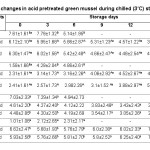 |
Table 1: Sensory changes in acid pretreated green mussel during chilled (3˚C) storage Click here to View figure |
Data are expressed as mean±standard deviation of ten panelists.
For marine seaweedy odor, natural sweet flavor and sourness scores, 10=pronounced and 1=absent; for ammoniacal odor,1=pronounced and 10=absent.
Means located on the same column with different superscripts (a-c) for each attribute tested are statistically different at p<0.05.
Means located on the same row with different superscripts (A-C) are statistically different at p<0.05.
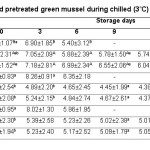 |
Table 2: Acceptability of acid pretreated green mussel during chilled (3˚C) storage Click here to View figure |
Acceptability ratings: 1= dislike extremely; 10=like extremelyData are expressed as mean±standard deviation of ten panelists.
Means of the same column having different superscripts (a-c) for each attribute tested are statistically different at p<0.05.
Means of the same row having different superscripts (A-C) are statistically different at p<0.05.
Lactic Acid Bacteria Count
Lactic acid bacteria (LAB) belongs to the group of spoilage organisms that rapidly proliferate under the anaerobic condition at low-temperature storage 19 but they can also grow on air-packaged and MAP products. They are known as dominant spoilage microorganisms that exhibits a selective characteristic by inhibiting the growth of other bacteria through the formation of lactic acid and bacteriocin.20 The LAB growth in pretreated and untreated green mussel is shown in Figure 1. The lactic and citric acid pretreatments significantly lowered the bacterial count of green mussel at day 3rd to day 12th compared to the untreated samples. There was no difference in the bacterial retardation of the two organic acids for the sampling days mentioned. There was no acceptable limit established for the lactic acid bacteria count in green mussel, thus, this study utilized the identified safety limit of food product which is 7 log CFU/g considered safe for human consumption.21 This limit was also used in some storage studies on green mussel.18, 20, 22 The untreated samples attained the mentioned limit on day 9 with 7.81 log CFU/g, the same day the sample was rejected during the sensory evaluation due to its unpleasant odor. For days 15th and 18th, the lactic acid pretreatment had significantly lower lactic acid bacteria count compared to citric acid pretreatments. The antimicrobial property of weak acids including lactic and citric acid are related to their concentration of undissociated acids (pKa). Lactic acid with higher pKa value has a higher antimicrobial property than the other acids with a lower pKa value like that of citric acid. Organic acids can pass through the cell membrane and are able to dissociate once inside the cell and acidify the internal pH to prevent the growth of the microorganism.23 The higher bacterial count of the citric acid pretreated sample can also be attributed to its higher molecular size and lower antimicrobial property.24
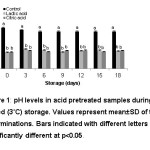 |
Figure 1: pH levels in acid pretreated samples during chilled (3˚C) storage. Values represent mean±SD of three determinations. Bars indicated with different letters were significantly different at p<0.05. |
Psychrophilic Bacteria Count
Even at low-temperature storage, spoilage organism still occurs and alter the quality of chilled products.19 Psychrotrophic organisms are the most important agents of spoilage during the cold storage. Their occurrence is known to abruptly increase during this type of storage and they are known to comprise most of the flora during the end of the product shelf life of chilled food products. Their final composition is irrespective of the initial composition but this is due to the low storage temperature itself.8, 25 In the current study, lactic and citric acid pretreatments obtained significantly lower bacteria count compared to the untreated samples on day 3rd and 6th as shown in Figure 2 (p<0.05). The two organic acids had similar effects on bacterial retardation on the said days of sampling because there was no difference detected between the two organic acids pretreated mussel. There was no established limit for psychrophilic bacteria in green mussel, thus the limit suggested from chilled storage of mackerel and anchovy which is 6 log CFU/g was used as the basis of safe consumption of the product.26 The untreated samples on day 9th attained 5.57 log CFU/g and were rejected because it is unfit for the sensory analysis. The lactic acid pretreated green mussel significantly maintained lower bacterial count from day 9th to 18th compared to citric acid pretreated sample. Lactic acid effectively has retarded microbial proliferation on the sample for 15 days and to help maintain the desirable green mussel quality characteristic compared to untreated samples. Antimicrobial effect was attributed to its undissociated property that acidifies the internal cell and controls bacterial proliferation on the samples.23
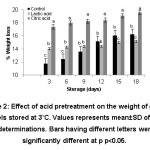 |
Figure 2: Effect of acid pretreatment on the weight of green Mussels stored at 3˚C. Valuesrepresents mean±SD of three determinations. Bars having differentletters wer significantly different at p p<0.05. |
Changes in pH
pH values are frequently used as the physical quality control for seafood products that are always assessed together with TVB-N and TMA-N values.18 The pH is an indicator of post-mortem conversion of glycogen to lactic acid and the degradation of muscle components during long storage.27 The pH value of organic acid pretreated samples was significantly lower compared to the untreated green mussels (Figure 3). There were no significant differences between the pH attained by lactic and citric acid pretreatments for 18 days. The pH of the untreated samples declined from pH 6.2 to pH 5.9 during 18 days storage. The decline of pH is due to different factors like post-mortem changes, degradation of muscle components and the fermentative conversion of glycogen.18, 28 It can also be attributed to the increasing microbial count and this condition can be considered its deterioration stage.4 The lower pH obtained by organic acid pretreatment can be attributed to the high sourness score of the two samples attained during sensory evaluation with the range of 6.62-5.91 for lactic acid pretreatment and 5.91-5.41 for citric acid pretreatments considered as distinct compared to the untreated sample with range score of 1.01-2.31 signifies the absence of sourness. The sourness level of organic acid pretreatments was acceptable for the panelist.
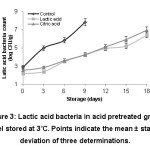 |
Figure 3: Lactic acid bacteria in acid pretreated green mussel stored at 3˚C. Points indicate the mean ± standard deviation of three determinations. |
Effect of Organic Acid on Weight Loss
The loss of mass and the decline in the yield of meat products is attributed to the loss of water during the manufacturing process.29 The weight loss attained by citric acid pretreated green mussel was significant compared to other samples for 18 days chilled storage (Figure 4). pH and ionic strength directly affect the ability of myofibrillar proteins and myofibrils to entrap water30 that can be attributed to a higher weight loss of organic acid in the pretreated samples. But high water retention in untreated samples did not extend the shelf life of the product because it might have served as nutrient and contributed to the microbial proliferation in the food products.31
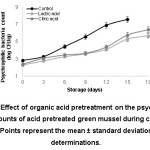 |
Figure 4: Effect of organic acid pretreatment on the psychrophilic bacteria counts of acid pretreated green mussel during chilled (3˚C)storage. Points represent the mean ± standard deviation of three determinations. |
Total Volatile Basic Nitrogen (TVB) Content During Storage
Total volatile basic amines (TVB) are commonly utilized indicator to assess seafood quality and this includes the different components like trimethylamine (by spoilage organism), dimethylamine (by autolytic enzyme in frozen storage), ammonia (by the deamination of amino acids and nucleotide catabolites) and other volatile basic nitrogenous compounds present in fish and fishery products.32,33 Spoilage of seafood products can be observed by the increasing TVB concentration that is related to the bacterial proliferation.34,35 Lactic and citric acid pretreatment effectively maintained lower TVB concentration on the day 3 to 9 compared to the untreated samples. There was no established limit for TVB in mussel, thus, the limit which is 15 mg N/100 g were used in this study.36 From the day 12th to 15th, the lactic acid pretreatment had significantly lower TVB values compared to the citric acid pretreatment (p<0.05).
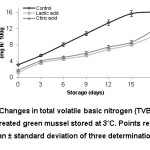 |
Figure 5: Changes in total volatile basic nitrogen (TVB) content of acid pretreated green mussel stored at 3˚C. Points represent the mean ± standard deviation of three determinations. |
Trimethylamine Nitrogen (TMA) Values
Trimethylamine nitrogen (TMA-N), another spoilage product commonly applied in the detection of freshness in marine fishes.16,33 In postmortem condition, enzyme produce by spoilage organism contributes in the metabolization of the extractive fraction of the fish muscle and results in the production of various volatile compounds that causes off flavors and odors. Lactic acid pretreatment had significantly lower TMA content from day 3 to 15 compared to the citric acid pretreated mussel and untreated samples as shown in Figure 6 (p<0.05). There was no significant difference in the TMA value on the day 18th between the two organic acid pretreated mussels. The TMA limit used in this study was 3 mg/ 100g for TMA-N of mussel.36 Lactic acid pretreatment effectively maintained at the safe limit for 15 days compared to the untreated samples. Citric acid pretreatment had a similar effect but not as effective as lactic acid pretreatment. Volatile compounds like TVB and TMA are the products of bacterial spoilage that can affect the food quality once its concentration surpassed the safety limit, lactic acid controlled its increase by preventing the rapid growth and proliferation of these microorganisms. The said spoilage product and its retardation effect are attributed to its antimicrobial property.
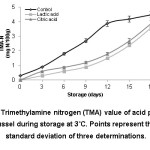 |
Figure 6: Trimethylamine nitrogen (TMA) value of acid pretreated green mussel during storage at 3˚C. Points represent the mean ± standard deviation of three determinations. |
Ammonia Content
Ammonia present in post-mortem flesh is derived from the deamination of adenine nucleotides to inosine monophosphate that is known to occur rapidly during the harvesting and death of the fish or within a few hours after storage in ice. Its increasing level reflects the decomposition of the muscle of food products37. Changes in ammonia content in green mussel during chilled storage for 18 days are presented in Figure 7. Lactic and citric acid pretreatments had significantly lower ammonia values compared to the control samples on the 3rd until day 9th (p<0.05). The limit used for the safe ammonia concentration was based on a study38 with finding that 0.2-0.3 mg/g level of ammonia in crayfish developed a bad odor that made the samples unacceptable to the sensory evaluation compared to the fresh sample with an ammonia level of 0.07-0.1 mg/g. The limit was attained by the untreated sample on day 9 of chilled storage, on the same day it was rejected by the panelist due to its ammoniacal odor. From the day 12 to 18, lactic acid pretreated green mussel had a lower ammonia content compared to citric acid pretreated samples (p<0.05). The organic acid pretreatment controlled the deamination of post-mortem flesh to retard ammonia occurrence in green mussels.
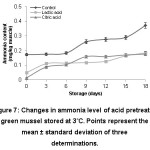 |
Figure 7: Changes in ammonia level of acid pretreated green mussel stored at 3˚C. Points represent the mean ± standard deviation of three determinations. |
Conclusion
Lactic acid pre-treatment is effective in controlling sensory, microbiological and physicochemical deterioration of green mussel during chilled storage. Preservation effect was also observed on citric acid pre-treatment but its drawback includes higher weight loss than lactic acid that can directly affect the yield of the product once utilized for commercial scale. Thus, the lactic acid can be effectively applied to food industry particularly in primary processing of shellfish like green mussels to extend shelf life and preserve quality up to 15 days compared to 6 days’ shelf life of untreated mussel.
Acknowledgments
This study acknowledged the support and research grant from Department of Science and Technology-Accelerated Science and Technology Human Resources Development Program (DOST-ASTHRDP) and Department of Science and Technology-Philippine Council for Agriculture, Aquatic, and Natural Resources Research and Development (DOST-PCAARD) Mussel Program.
Conflict of Interest
The authors have no conflict of interest.
References
- Azanza M. P., Azanza R., Ventura S. Heat Shocking of Philippine Green Mussels, Perna viridis. International Journal of Food Science and Technology. 2005;40:689-694.
CrossRef - Philippine Statistics Authority (PSA). Fisheries Situationer PSA-Department of Agriculture. 2016;1-28.
- Batista I., Mendes R. Processing Mollusc, Shellfish and Cephalopods. In: Second International Congress on Seafood Technology on Sustainable, Innovative and Healthy Seafood. Food and Agriculture Organization Fisheries and Aquaculture Proceedings. 2012;85-108.
- Lima M., Melo M., Monteiro A. Evaluation of the Processing of Perna perna mussels: The Influence of Water Quality Involved in the Cooling Operations in the Physico-Chemical and Microbiological Characteristic of the Product. Journal of Food Science and Agriculture. 2013;93:3322-3329.
CrossRef - Taheri S., Motalebi A. A., Fazlara A. Antioxidant Effect of Ascorbic Acid on the Quality of Cobia (Rachycentron canadum) Fillets During Frozen Storage. Iranian Journal of Fisheries Sciences. 2012;11(3):666-680.
- Lianou A., Koutsoumanis K. Organic Acids and Other Chemical Treatments for Microbial Decontamination of Food. Woodhead Publishing Limited. 2012;20:1-73.
CrossRef - Gomis D. B. HPLC Analysis of Organic Acids. Food Analysis by HPLC. 1992;371-385.
- Whittle K. J., Hardy R., Hobbs G. Chilled Fish and Fishery Products. In: Chilled Foods: The State of the Art. Elsevier Applied Science. 1990;87-116.
- Harris K., Miller M. F., Loneragan G. H., Brashears M. M. Validation of the Use of Organic Acids and Acidified Sodium Chlorite to Reduce Escherichia coli O157 and Salmonella typhimurium in Beef Trim and Ground Beef in a Simulated Processing Environment. Journal of Food Protection. 2006;69:1802-1807.
CrossRef - Hur S. J., Jin S. K., Park J. H., Jung S. W., Lyn H. J. Effect of Modified Atmosphere Packaging on Quality Characteristic of Low Grade Beef During Cold Storage. Asian Australias Journal of Animal Science. 2013;26(12):1781-1789.
CrossRef - Greene V. Influence of Temperature History in Response of Psychrophiles to Different Temperatures. Journal of Dairy Sciences. 1985;42:1097-1098.
CrossRef - Woyewoda A., Shaw S., Ke P., Burns B. Recommended Laboratory Methods for Assessment of Fish Quality. Canadian Technical Report of Fisheries and Aquatic Sciences. 1986;1448.
- Pastoriza L., Sampedro G., Herrera J. J., Cabo M. L. Effects of Modified Atmosphere Packaging on Shelf Life of Iced Fresh Hake Slices. Journal of Science Food Agriculture. 1996;71:541-547.
CrossRef - Conway E. T. Microdiffusion and Volumetric Error. London Crosby Lockwood and Son Ltd. 1950.
- Scheiner D. Determination of Ammonia and Kjeldahl Nitrogen by Indophenols Method. Water Research Journal. 1976;10:31-36.
CrossRef - Gokoglu N. A Descriptive Method for Sensory Evaluation of Mussels. Lebensmittel-Wissenchaft & Technologie. 2002;35:563-567.
CrossRef - Ashie I., Smith J., Simpson B. Spoilage and Shelf life Extension of Fresh Fish and Shellfish. Critical Reviews in Food Science and Nutrition. 1996;36(1):87-121.
CrossRef - Terzi G., Gucukoglu A., Cadirci O., Kevenk T. O., Alisarli M. Effects of Chitosan and Lactic Acid Immersion on the Mussels Quality Changes During the Refrigerated Storage. Research Gate. 2012;1-8.
- Caglak E., Cakli S., Kilinc B. Microbiological, Chemical and Sensory Assessment of Mussels (Mytilus galloprovincialis) Stored Under Modified Atmosphere Packaging. European Food Research Technology. 2008;226:1293-1299.
CrossRef - Goulas A. E., Chouliara I., Nessi E., Kontominas M. G., Savvaidis I. N. Microbiological, Biochemical and Sensory Assessment of Mussels (Mytilus galloproviancilis) Stored Under Modified Atmosphere Packaging. Journal of Applied Microbiology. 2005;98:752-760.
CrossRef - International Commission on Microbiological Specifications for Foods (ICMSF). Microorganism in Foods Sampling for Microbiological Analysis: Principles and Scientific Applications. 1986;2(2):181-196.
- Masniyom P., Benjama O. Effect of Lactic, Acetic and Citric Acids on Quality Changes of Refrigerated Green Mussel Perna viridis (Linnaeus, 1758). Songklanakarin Journal of Science and Technology. 2007;29(4):1123-1134.
- Giannuzzi L., Zaritzky N. Effect of Ascorbic Acid in Comparison to Citric and Lactic Acid in Listeria monocytogenes Inhibition at Refrigeration Temperatures. Lebensmittel-Wissenchaft & Technologie. 1996;29:278-285.
CrossRef - Ouattara B., Simard R., Holley R., Piette G., Begin A. Inhibitory Effecto of Organic Acids Upon Meat Spoilage Bacteria. Journal of Food Protection. 1997;60:246-253.
CrossRef - Kaysner C. A. Contamination and Spoilage. Seafood Research Center Academic Press. 1999;2001- 2007.
- Mol S., Erkan N., Ucok D., Tosun S. Effects of Psychrophilic Bacteria to Estimate Fish Quality. Journal of Muscle Foods. 2006;18:120-128.
CrossRef - Songsaeng S., Sophanodora P., Kaewsrithong J., Oshima T. Quality Changes in Oyster (Crassotrea belcheri) During Frozen Storage as Affected by Freezing and Antioxidant. Food Chemistry. 2010;123: 286-290.
CrossRef - Cao R., Xue C., Liu Q. Changes in Microbial Flora of Pacific Oyster (Crassotrea gigas) During Refrigerated Storage and its Shelf-life Extension by Chitosan. International Journal of Food Microbiology. 2009;131:272-276.
CrossRef - Almonacid S., Bustamante J., Simpson R., Urtubia A., Pino M., Teixeira A. Commercially Sterilized Mussel Meats (Mytilus chilensis): A study on process yield. Journal of Food Science. 2012;77(6):127.
CrossRef - Goncalves A., Ribeiro J. Do Phosphate Impove the Seafood Quality: Reality and Legislation. Pan-American Journal of Aquatic Sciences. 2008;3(3):237-247.
- Sengor G., Kalafatoglu H., Gun H. The Determination of Microbial Flora, Water Activity and Chemical Analyses in Smoked, Canned Mussel (Mytilus galloprovincialis, L.). Turkish Journal of Veterinary Animal Science. 2004;28:793-797.
- Huss H. Quality and Quality Changes in Fresh Fish. FAO Fisheries Technical Paper. 1995;348:195.
- Turan, H., Sonmez G., Celik M. Y., Yalcin M., Kaya Y. Effect of Different Salting Process on the Storage Quality of Mediterranean Mussel (Mytilus galloprovincialis 1819). Journal of Muscle Foods. 2006;18:380-390.
CrossRef - Mitsubayashi K., Kubotera Y., Yano K., Hashimoto Y., Kon T., Nakakura S. Trimethylamine Biosensor with Flavin-Containing Monooxygenase Type 3 (FMO3) for Fish-Freshness Analysis. Sensors and Actuators B: Chemical. 2004;103:463–467.
CrossRef - Siripatrawan U., Sanguandeekul R., Narakaew V. An Alternative Freshness Index Method for Modified Atmosphere Packaged Abalone Using Artificial Neural Network. Lebensmittel-Wissenchaft & Technologie. 2009;42:343-349.
CrossRef - Erkan N. Changes in Quality Characteristics During Cold Storage of Shucked Mussels and Selected Chemical Decomposition Indicators. Journal of Science Food and Agriculture. 2005;85:2625-2630.
CrossRef - Huang Y., Kouadio K., Gates K. Effect of Packaging on Chemical Changes and Quality of Refrigerated Spot (Leiostomus xanthurus). Journal of Aquatic Food Production Technology. 1992;2:111-127.
- Wang M. Y., Brown W. D. Effects of Elevated CO2 on Storage of Freshwater Crayfish (Pacifastacus leniusculus). Journal of Food Science. 48:158-162.
CrossRef

This work is licensed under a Creative Commons Attribution 4.0 International License.


